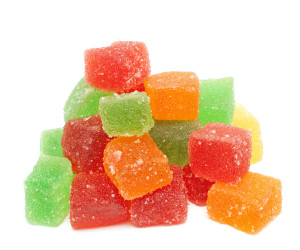
Today is the day you face the devastating truth that your best and most delicious friend is, in fact, your complexion’s biggest foe: Sugar. It’s frenemy No. 1. Cue the tears.
While the word ‘glycation’ does have the same inviting ring as ‘vacation’, it’s not nearly as nice. ‘Glycation’ is the internal process that occurs after sugar is ingested.
“Intake of high glycemic food and beverages leads to inflammation and glycation causing an enormous amount of visible distress on our skin,” explains Elena, president of the Society of Plastic Surgical Skin Care Specialists (SPSSCS).
Once the sugar is coursing through your bloodstream, it binds with proteins in the skin, triggering inflammation that damages tissue and causes premature aging. Since collagen is the most prevalent protein in the body (between 25% – 30% of the protein in mammals), guess what takes the hit?
A recent article in New Beauty’s winter issue breaks it down into even more terrifying detail, explaining that, “As glycation ensues, collagen and elastin fibers become brittle, losing their ability to strengthen and give elasticity to skin.” And that’s not all. Glycation produces free-radical by-products called AGEs (advanced glycation end products) — one of which is hydrogen peroxide (another cause of inflammation) — and accelerates cell damage and aging by feeding off of healthy collagen and elastin. AGEs also deactivate your body’s natural antioxidant enzymes, making skin more vulnerable to environmental damage like UV rays and cigarette smoke, (and that’s just the science-bit).
So how exactly does one know if they have entered the “chronic” stage of sugar consumption? The damage from chronic sugar intake can occur in as little as a few months or as much as a few years, and you’d be hard-pressed not to recognize it when you look in the mirror — a sallow, sagging, and discolored complexion. You may also notice bouts of acne, since high levels of sugar can trigger a hormonal release, stimulating oil production that can lead to increase in breakouts and rosacea caused by the inflammation and AGEs. *seriously, unhand that cupcake.
“Clients come to us seeking great healthy looking skin. In order to achieve this, I educate them on the importance of great antioxidants internally as well as topically and recommend a diet with foods rich in antioxidants to fight free radicals,” explains Elena.
Obviously, the best way to fight premature aging from the glycation process is to eliminate it from your diet, but we understand if denying yourself access to the deliciousness that is sugar is out of the question. Simply cutting back on the sweet stuff could be enough. Keeping your sugar intake to 10% of your daily calories is a good guideline — and considering that whole grains, fruits and vegetables actually turn to glucose once digested, and that there are a slew of “hidden” sugars in labeled ingredients like high fructose corn syrup, dextrose and fruit juice concentrate — it may not be an easy one. Another way to keep those AGEs from forming is to supplement your diet with antioxidant-rich fruits, nuts and vegetables, and looking into topical treatments that contain antioxidants like green tea, vitamins C and E and other antioxidant-rich products that claim to help counteract the effects of sugar on the skin.
“One of my favorite antioxidants is L-ascorbic acid (Vitamin C) which helps to protect against environmental damage of our skin and also helps with the absorption of iron. My motto to clients is, “Be good to our bodies internally and our skin will project beautiful healthy looking skin externally!” exclaims Elena.
This article was originally published by Smart Beauty Guide
Go
Questions or want to talk to Dr. Tahernia?
Give us a call: (310) 614-9701